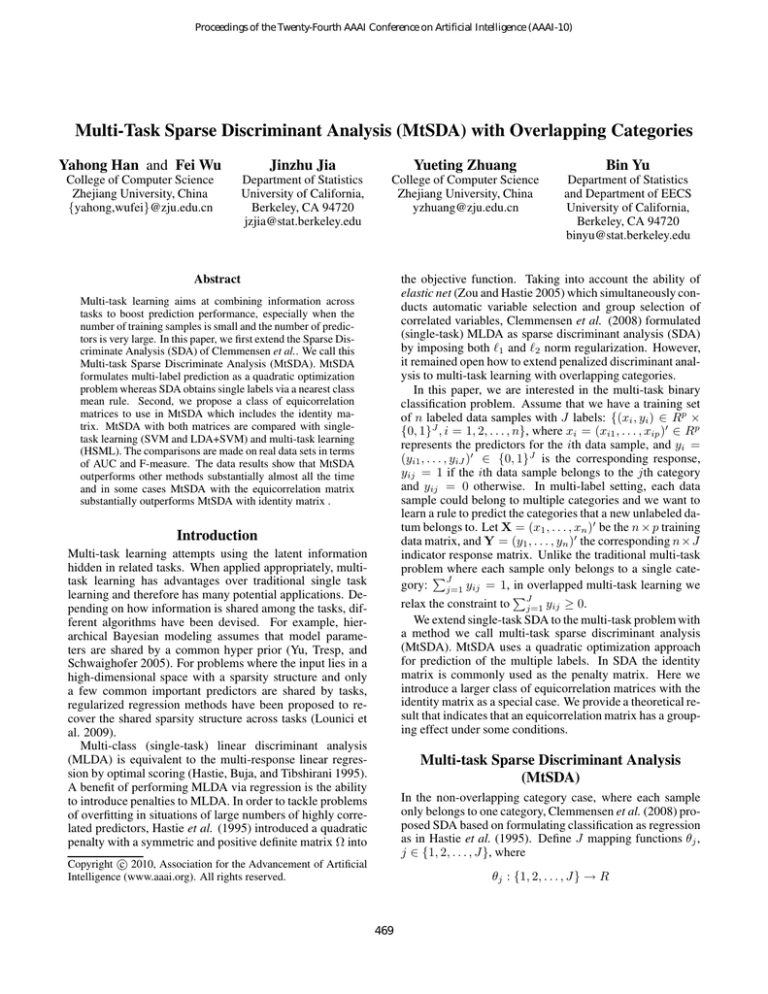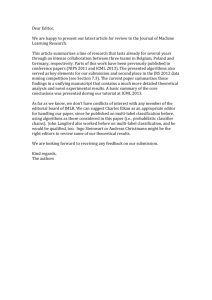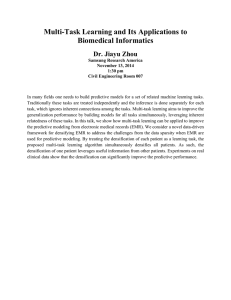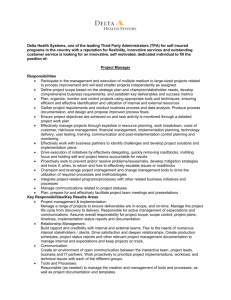
Proceedings of the Twenty-Fourth AAAI Conference on Artificial Intelligence (AAAI-10)
Multi-Task Sparse Discriminant Analysis (MtSDA) with Overlapping Categories
Yahong Han and Fei Wu
Jinzhu Jia
Yueting Zhuang
Bin Yu
College of Computer Science
Zhejiang University, China
{yahong,wufei}@zju.edu.cn
Department of Statistics
University of California,
Berkeley, CA 94720
jzjia@stat.berkeley.edu
College of Computer Science
Zhejiang University, China
yzhuang@zju.edu.cn
Department of Statistics
and Department of EECS
University of California,
Berkeley, CA 94720
binyu@stat.berkeley.edu
Abstract
the objective function. Taking into account the ability of
elastic net (Zou and Hastie 2005) which simultaneously conducts automatic variable selection and group selection of
correlated variables, Clemmensen et al. (2008) formulated
(single-task) MLDA as sparse discriminant analysis (SDA)
by imposing both ℓ1 and ℓ2 norm regularization. However,
it remained open how to extend penalized discriminant analysis to multi-task learning with overlapping categories.
In this paper, we are interested in the multi-task binary
classification problem. Assume that we have a training set
of n labeled data samples with J labels: {(xi , yi ) ∈ Rp ×
{0, 1}J , i = 1, 2, . . . , n}, where xi = (xi1 , . . . , xip )′ ∈ Rp
represents the predictors for the ith data sample, and yi =
(yi1 , . . . , yiJ )′ ∈ {0, 1}J is the corresponding response,
yij = 1 if the ith data sample belongs to the jth category
and yij = 0 otherwise. In multi-label setting, each data
sample could belong to multiple categories and we want to
learn a rule to predict the categories that a new unlabeled datum belongs to. Let X = (x1 , . . . , xn )′ be the n × p training
data matrix, and Y = (y1 , . . . , yn )′ the corresponding n× J
indicator response matrix. Unlike the traditional multi-task
problem where each sample only belongs to a single catePJ
gory: j=1 yij = 1, in overlapped multi-task learning we
PJ
relax the constraint to j=1 yij ≥ 0.
We extend single-task SDA to the multi-task problem with
a method we call multi-task sparse discriminant analysis
(MtSDA). MtSDA uses a quadratic optimization approach
for prediction of the multiple labels. In SDA the identity
matrix is commonly used as the penalty matrix. Here we
introduce a larger class of equicorrelation matrices with the
identity matrix as a special case. We provide a theoretical result that indicates that an equicorrelation matrix has a grouping effect under some conditions.
Multi-task learning aims at combining information across
tasks to boost prediction performance, especially when the
number of training samples is small and the number of predictors is very large. In this paper, we first extend the Sparse Discriminate Analysis (SDA) of Clemmensen et al.. We call this
Multi-task Sparse Discriminate Analysis (MtSDA). MtSDA
formulates multi-label prediction as a quadratic optimization
problem whereas SDA obtains single labels via a nearest class
mean rule. Second, we propose a class of equicorrelation
matrices to use in MtSDA which includes the identity matrix. MtSDA with both matrices are compared with singletask learning (SVM and LDA+SVM) and multi-task learning
(HSML). The comparisons are made on real data sets in terms
of AUC and F-measure. The data results show that MtSDA
outperforms other methods substantially almost all the time
and in some cases MtSDA with the equicorrelation matrix
substantially outperforms MtSDA with identity matrix .
Introduction
Multi-task learning attempts using the latent information
hidden in related tasks. When applied appropriately, multitask learning has advantages over traditional single task
learning and therefore has many potential applications. Depending on how information is shared among the tasks, different algorithms have been devised. For example, hierarchical Bayesian modeling assumes that model parameters are shared by a common hyper prior (Yu, Tresp, and
Schwaighofer 2005). For problems where the input lies in a
high-dimensional space with a sparsity structure and only
a few common important predictors are shared by tasks,
regularized regression methods have been proposed to recover the shared sparsity structure across tasks (Lounici et
al. 2009).
Multi-class (single-task) linear discriminant analysis
(MLDA) is equivalent to the multi-response linear regression by optimal scoring (Hastie, Buja, and Tibshirani 1995).
A benefit of performing MLDA via regression is the ability
to introduce penalties to MLDA. In order to tackle problems
of overfitting in situations of large numbers of highly correlated predictors, Hastie et al. (1995) introduced a quadratic
penalty with a symmetric and positive definite matrix Ω into
Multi-task Sparse Discriminant Analysis
(MtSDA)
In the non-overlapping category case, where each sample
only belongs to one category, Clemmensen et al. (2008) proposed SDA based on formulating classification as regression
as in Hastie et al. (1995). Define J mapping functions θj ,
j ∈ {1, 2, . . . , J}, where
c 2010, Association for the Advancement of Artificial
Copyright Intelligence (www.aaai.org). All rights reserved.
θj : {1, 2, . . . , J} → R
469
assigns a score to each category. Denote by θ the J × J
score matrix, with (i, j) element θij defined as
Let θ j,: be the jth row of θ. For the non-overlapping category case, when (x, y) belongs to the jth category, yθ =
θj,: . So Equation (3) is equivalent to
θ ij = θj (i).
j0 = arg min kθ̂j,: − x∗ ′ β̂k2 .
θij is the score assigned to the ith category by mapping
θj . Denote by θj the jth column of θ. Let Ω be any p × p
positive definite matrix and IJ×J the J × J identity matrix.
Denote by βj ∈ Rp the coefficient vector from a linear regression of Yθj on X and β = (β 1 , . . . , βJ ) the p × J
coefficient matrix. The SDA in (Clemmensen, Hastie, and
Ersbøll 2008) is formulated as
j
The equivalence is in the sense that the optimizer ŷ of
(3) has its j0 th element ŷj0 = 1 and 0 elsewhere. (4) has a
very good geometric interpretation: each data example in the
training data set is represented by Y θ and all of the training
data are distributed into J points, i.e., θj,: (j = 1, ..., J).
The new unlabeled x∗ is represented by x∗ ′ β which is an
approximation of y ∗ θ. x∗ is assigned to the class whose
centroid in the new represented space is the closest to x∗ ′ β
in term of Euclidean distance. From this geometric point of
view, (4) is a nearest class mean rule.
For situations where the unlabeled x∗ belongs to multiple
categories, we cannot apply nearest class mean rules such
as (2) and (4) anymore. The formula (3) can be extended to
(5) by removing the constraint that each data example only
belongs to one category. The prediction of y ∗ for x∗ with
multiple labels is then:
J
1X
min
||Yθ j − Xβ j ||22 + λ2 β ′j Ωβj + λ1 ||βj ||1 ,
β,θ n
j=1
s.t.
1
(Yθ)′ (Yθ) = I,
n
(1)
where ||A||22 = i,j A2i,j is the ℓ2 norm of matrix A.
After all of the parameters β and θ in (1) are obtained and
a new unlabeled datum with p predictors x∗ ∈ Rp is given,
SDA (Clemmensen, Hastie, and Ersbøll 2008) implemented
nearest class mean rule to predict a group for x∗ . It assigns
x∗ into category j0 , such taht
P
ŷ ∗ = arg min kyθ − x∗ ′ β̂k2 .
y∈{0,1}J
j
(2)
where Mj is the mean of predictors in the jth category, ΣW
is the so-called within common covariance matrix and Ω is
the penalty matrix.
Choice of Penalty Matrix Ω
The quadratic penalty is used to avoid overfitting when predictors have high correlations or the number of predictors
are much larger than the number of data samples (p ≫
n). Several different penalty matrices have been proposed
for various practical applications. For example, a second
derivative-type penalty matrix is used for hyperspectral data
analysis (Yu et al. 1999). In (Clemmensen, Hastie, and
Ersbøll 2008), the identity matrix Ω = Ip×p is used. But
there are no theoretical results about how to choose a good
penalty matrix. In this paper, we consider a more general
penalty matrix than the identity matrix. We choose Ω to be
an equicorrelation matrix ∆, defined as follows.
Definition 1 (Equicorrelation Matrix). Equicorrelation
matrix ∆ is a symmetric definite matrix,
Prediction of Multi-label
In multi-label learning settings, the above nearest class mean
rule cannot be applied because each data example belongs to
multiple categories rather than exactly one category. From
Equation (2), we see that each point (x, y) is represented
by x′ β and nearest class mean rule is implemented on the
transformed point. By using optimal scoring and solving
optimization problem (1), x′ β can be approximated by yθ
with learned θ. Therefore, we have two approximate ways
to represent x , namely x′ β and yθ.
Given new x∗ with unknown class label y ∗ , we also can
represent x∗ with x∗ ′ β. Another potential representation
y ∗ θ of x∗ can be obtained by minimizing the Euclidean distance between x∗ ′ β and y ∗ θ over all possible values of y ∗
and the label vector of x∗ is the minimizer of the minimization problem.
Denote by 1 a vector with all elements equal to 1. For
non-overlapping categories, y ∗ can be obtained by the following quadratic optimization problem:
s.t.
y∈{0,1}J
∆ = (1 − ρ)Ip×p + ρ1p 1′p
1 ρ ... ρ
ρ 1 ... ρ
, (1 − p)−1 < ρ < 1,
=
..
..
... ...
.
.
ρ
ρ
... 1
where 1p is a p × 1 vector with all of its elements 1.
This equicorrelation matrix is more general than the identity matrix, because when ρ = 0, it specializes to the identity
matrix.
We argue that SDA with equicorrelation matrix ∆ in formula (1) will not only avoid overfitting, but also produce
a grouping effect. That is, given the jth task, the distance
∗′
ŷ = arg min kyθ − x β̂k2
(5)
The only difference between (3) and (5) is that the latter
equation does not have the single-category constraint, while
the former one has this constraint.
j0 = arg min(x∗ ′ β̂ − Mj′ β̂)′ (ΣW + λ2 Ω)(x∗ ′ β̂ − Mj′ β̂),
∗
(4)
(3)
y1 = 1.
Suppose the estimated ŷ ∗ has j0 th element 1 and 0 elsewhere, then x∗ is classified to the j0 th class.
470
Algorithm 1 The Calculation of Threshold
Input training data X ∈ Rn×p as well as its corresponding indicator matrix Y ∈ {0, 1}n×J and predicted class
label Ŷ ∈ Rn×J by (11).
1: Convert Ŷ ∈ Rn×J into 1 × (n × J) vector S.
2: Sort S and set the values of the first k0 ( k0 = 1, . . . , n
) smallest values of Ŷ as 0 and the rest values of Ŷ as 1,
calculate the F-measure.
3: Obtain the final k0 which achieve best F-measure.
4: Set the threshold thresh as (Sk0 + Sk0 +1 )/2.
Output threshold.
of the coefficients of highly positively correlated predictors
will tend to be close when they have the same sign, if λ2 is
large and ρ is not too close to 1.
Theorem 1. Assume that
Xl (l = 1,P. . . , p), are
Ppredictors
n
n
normalized such that n1 i=1 Xil = 0 and n1 i=1 Xil2 =
1. Let θ̂, β̂ denote the solution of (1), and rl1 l2 the empirical correlation of Xl1 and Xl2 . Define the distance of l1 th
predictor and l2 th predictor for jth task as
β̂l1 j − β̂ l2 j (j)
Dl1 ,l2 =
.
kYθ̂j k2
If sign(β̂l1 j ) = sign(β̂l2 j ) then we have
p
2(1 − rl1 l2 )
(j)
Dl1 ,l2 ≤
.
λ2 (1 − ρ)
A proof of Theorem 1 can be found in the appendix.
which is a standard Procrustes problem (Eldén and Park
1999). Taking SVD n−1/2 Xβ = USV′ , by solution of
Procrustes we have n−1/2 Yθ = UV′ . Thus the solution for
(7) is
θ̂ = n1/2 Y† UV′ ,
(9)
Algorithm of MtSDA
where Y† denotes the Moore-Penrose inverse (Golub and
Van Loan 1996) of Y.
This section provides detailed descriptions on the estimation
of parameters in (1) and the prediction of class label for unlabeled data.
Parameter Estimation There are two parameter vectors
to be estimated, i.e., β and θ in (1). We design an iterative
optimization algorithm for (1).
For fixed θ in (1) we obtain the elastic-net like problem
for the jth (j = 1, . . . , J) task as follows
1
βˆj = arg min
||Yθ j − Xβ j ||22 + λ2 β ′j ∆βj + λ1 ||β j ||1 .
βj n
(6)
In this section, we assume ρ is known. When it is not as in
the data section, we use cross validation to choose one from
data. Equation (6) takes the form of a modified naı̈ve elastic
net problem (Zou and Hastie 2005).
√ Since the matrix ∆ is
symmetric and positive definite, ∆ always exists. Define
an artificial data set (ỹ, X̃) by
X
Yθ j
−1/2
√
X̃(n+p)×p = (1+λ2 )
, ỹ(n+p) =
.
0
λ2 ∆
p
p
Let γ = λ1 / (1 + λ2 ) and β̃ = (1 + λ2 )β, then (6)
can be written as
L(γ, β̃) = ||ỹ − X̃β̃||22 + γ||β̃||1 ,
which is a standard lasso problem (Tibshirani 1996). Performing the LARS algorithm (Tibshirani 1996) on this augmented problem yields the solution of (6).
For fixed β we have
1
θ̂ = arg min ||Yθ − Xβ||22 .
θ n
(7)
1
′
s.t.
(Yθ) (Yθ) = I.
n
Rewrite (7) as
θ̂ = arg min ||n−1/2 Yθ − n−1/2 Xβ||22 ,
θ
′ s.t.
n−1/2 Yθ
n−1/2 Yθ = I,
Prediction of Labels After β̂ and θ̂ are estimated, the label matrix Ŷ∗ for m test examples X∗ ∈ Rm×p is given by
(5) discussed before . That is,
Ŷ∗ = arg min kYθ − X∗ βk22 ,
Y
(10)
the solution of which is
Ŷ∗ = X∗ βθ † .
(11)
It is apparent that the values in Ŷ∗ are continuous rather
than binary. Here a threshold is learned to quantize Ŷ∗ by
algorithm 1. After the thresh is learned from training data,
we could use thresh to quantize Ŷ∗ .
We summarize our MtSDA in Algorithm 2.
Algorithm 2 MtSDA for Classification with Overlapping
Categories
Input training data matrix X ∈ Rn×p , corresponding
indicator matrix Y ∈ {0, 1}n×J and test data matrix
X∗ ∈ Rm×p .
1: Initialize θ = n1/2 Y† E:,1:J , where E = In×n
2: For l = 1, . . . , J solve the elastic-net like problem (6);
3: For fixed β compute the optimal scores by (9);
4: Repeat step 2 and 3 until convergence;
5: Update β for fixed θ by solving (6);
6: Compute Ŷ∗ by (11) and Algorithm 1.
Output indicator matrix Ŷ∗ for test data.
Related Work
A straightforward approach to perform multi-label learning
is to construct a binary classifier for each label. Instances
relevant to each given label form the positive class, and the
rest form the negative class (Joachims, Nedellec, and Rouveirol 1998). However, the one-against-the-rest approach
(8)
471
fails to keep the correlation information among different labels and significantly deteriorates the classification performance. Bucak et al. (2009) proposed multi-label ranking to
address the multi-label learning problem. Multi-label ranking avoided constructing binary classifiers and intended to
order all the relevant classes at higher rank than the irrelevant ones. Although multi-label ranking is applicable when
the number of classes is very large, it suffers from the inability of capturing the correlation of labels. Recently, a
number of approaches have been developed for multi-label
learning that exploit the correlation among labels such as
RankSV M (Elisseeff and Weston 2002) and Hypergraph
learning (Sun, Ji, and Ye 2008). When structure can be imposed on the label space, some sparsity-based multi-task
learning approaches were used with a mixed (2, 1)-norm
(Argyriou, Evgeniou, and Pontil 2008) to induce common
features across tasks. In this paper, the structure of the prediction coefficients is also sparse, but we do not have any
other structure information on them. Actually, our data does
not seem to support further structure information.
Table 1: Statistics for the data sets used. J, p, and N denote the number of tasks, the number of predictors, and the
total number of instances. MaxNPI and MinNPI denote the
maximum and the minimum number of positive instances
for each topic (label) respectively. The statistics of the Yahoo data collection are the average of the 11 data sets.
Dataset
J
p
N
MaxNPI MinNPI
Yahoo
NUS-6
NUS-16
MM2.0
18
6
16
25
23,970
634
634
892
10,626
10,000
10,000
10,000
4,488
2,686
2,686
3,988
129
1,004
337
107
five partitions. For each partition, we obtained the prediction performance. The average performance and standard
deviations are reported.
Different penalty matrices can be used in MtSDA for
multi-label learning. The MtSDA with identity matrix I and
equicorrelation matrix ∆ are named as MtSDA (Ω = I)
and MtSDA (Ω = ∆) respectively. To evaluate classification and annotation performance, we compare MtSDA
with two single-task learning algorithms and one recently
developed multi-task learning algorithm. The single-task
learning algorithms consist of SVM with a linear kernel
and LDA+SVM. The SVM is applied on each label using
a one-against-the-rest scheme. For LDA+SVM, the Linear
Discriminant Analysis (LDA) is applied first on each label
for dimension reduction before linear SVM is applied. The
compared multi-task learning algorithm is HSML (Hypergraph spectral multi-label) (Sun, Ji, and Ye 2008). HSML
constructs a hypergraph to capture the correlation information in different labels, and learns a lower-dimensional embedding in which the linear Support Vector Machine (SVM)
is applied for each label separately.
The area under the ROC curve (AUC) is used to measure
the performance for Webpage classification and image annotation. To measure the global performance across multiple
tasks, according to (Lewis 1991) we use the microaveraging method. In order to measure the performance of image
annotation, the F-measure (harmonic mean of precision and
recall) is preferred.
The AUC scores from each algorithm are reported in Table 2. As a whole, MtSDA seems to provide much bet-
Experiments
We use data from three open benchmark data collections to
evaluate our method. The first one is the 11 top-level multitopic webpage data set from Yahoo (Kazawa et al. 2005;
Ji et al. 2008). For details of the Yahoo data collection
please refer to Ji et al. (2008). The second is annotated
images from the NUS-WIDE data collection (Chua et al.
2009) with multiple tags. We randomly sampled 10, 000
images from the NUS-WIDE data collection. Five types of
low-level visual features (predictors) extracted from these
images were concatenated and normalized into one 634dimension predictor vector for each image. For the ground
truth of image annotation we chose two indicator matrices
for the selected data samples to form two data sets– NUS6 and NUS-16. For the two data sets, the top 6 and 16
tags which label the maximum numbers of positive instances
(NPI) were respectively selected. So, the correlations between tags in NUS-6 is more dense than those in NUS-16.
The third annotated image data set is from the MSRA-MM
dataset (Version 2.0) (Wang, Yang, and Hua 2009). We randomly sampled 10,000 multi-tagged images and the top 25
tags which label the maximum number of positive instances
(NPI) were selected. Six types of low-level visual features
were extracted from these images and concatenated and normalized into one 892-dimension vector for each image. We
call this dataset MM2.0. We summarize some statistics for
these data sets in Table 1. MaxNPI and MinNPI denote the
maximum and the minimum number of positive instances
for each topic (label) respectively in Table 1.
For the training data, we randomly sampled 1,000 samples from each of the 11 Yahoo data sets same as (Ji et al.
2008). For each of NUS-6, NUS-16 and MM2.0, we randomly sampled 5,000 samples as training data. The remaining data were used as the corresponding test data. This process was repeated five times to generate five random training/test partitions. At the first random partition, we tuned
the tuning parameters ρ, λ1 and λ2 . These tuning parameters were then fixed to train the MtSDA model for all these
Table 3: Summary of performance for the four compared
algorithms on NUS-6 , NUS-16 and MM2.0 in terms of Fmeasure. All parameters of the four algorithms are tuned
by 5-fold cross-validation, and the average F-measure over
5 random sampling of training instances are reported. The
highest performance is highlighted in each case.
Dataset
472
NUS-6
NUS-16
MM2.0
SVM
0.4018±0.0269
0.2207±0.0229
0.2089±0.0143
LDA+SVM
0.4018±0.0269
0.2207±0.0229
0.2089±0.0143
HSML
0.3994±0.0412
0.2463±0.0116
0.3626±0.0133
MtSDA (Ω=I)
0.4232±0.0706
0.2945±0.0681
0.3509±0.0198
MtSDA (Ω=∆)
0.4554±0.0266
0.3410±0.0113
0.3629±0.0461
Table 2: Summary of performance for the compared algorithms on 11 Yahoo data sets, NUS-6, NUS-16 and MM2.0 in terms
of AUC. The average performance and standard deviations over 5 random training/test partitions are reported. The highest
performance is highlighted in each case.
Dataset
Arts
Business
Computers
Education
Entertainment
Health
Recreation
Reference
Science
Social
Society
NUS-6
NUS-16
MM2.0
SVM
0.5357±0.0167
0.8862±0.0070
0.7532±0.0030
0.5915±0.0485
0.6605±0.0194
0.7120±0.0241
0.5789±0.0134
0.6927±0.0342
0.5233±0.0067
0.7463±0.0253
0.6108±0.0802
0.6247±0.0777
0.6002±0.1123
0.7502±0.0182
LDA+SVM
0.5238±0.0011
0.8807±0.0005
0.7540±0.0008
0.5645±0.0659
0.6137±0.0008
0.6657±0.0059
0.5589±0.0006
0.6453±0.0068
0.5150±0.0060
0.6268±0.0080
0.6194±0.0538
0.6247±0.0777
0.6002±0.1123
0.7502±0.0182
HSML
0.5771±0.0022
0.8895±0.0011
0.7664±0.0014
0.5922±0.0058
0.6608±0.0041
0.7220±0.0052
0.5967±0.0023
0.7041±0.0030
0.5575±0.0056
0.7471±0.0039
0.6278±0.0051
0.6548±0.0709
0.6414±0.0775
0.7726±0.0175
ter multi-label classification performance than the other algorithms even in the p ≫ n situation, i.e., on average
p ≈ 23, 970 and n = 1, 000 for the 11 Yahoo data sets.
The F-measure of image annotation is reported in Table 3.
The MtSDA provides better annotation performance on the
NUS-6, NUS-16 and MM2.0 data sets. Moreover, MtSDA
(Ω = ∆) outperforms MtSDA (Ω = I) slightly.
Figure shows the effect of the parameter ρ on MtSDA
(Ω = ∆). It depicts the AUC scores of MSDA (Ω = ∆) on
four data sets with respect to different value of the parameter
ρ = k1 on different k ∈ {1, 2, . . . , 10}. When we changed
ρ, the other tuning parameters λ1 and λ2 were fixed as the
tuned values at the first random partition. We used the results
of MtSDA (Ω = I) as baseline. For each ρ, the average of
AUC as well as its 95% confidence bounds over five random
training/test partitions are plotted. 95% confidence bound of
the average of a set V = {v1 , v2 , . . . , vs } is defined as V̄ ±
1.96σ
√ V , where V̄ is the average of V and σV is the standard
s
deviation of V . We can see that the parameter ρ generally
has impact on the AUC of MtSDA (Ω = ∆). However,
when the variability is taken into account, the impact of ρ 6=
0 is less obvious.
MtSDA (Ω=I)
0.7610±0.0131
0.8934±0.0171
0.8082±0.0152
0.7200±0.1058
0.8005±0.0055
0.8255±0.0577
0.7699±0.0182
0.8267±0.0131
0.7944±0.0178
0.7925±0.1272
0.7598±0.0174
0.6824±0.0316
0.5752±0.0716
0.7331±0.0415
MtSDA (Ω=∆)
0.7620±0.0119
0.9034±0.0070
0.8184±0.0109
0.7695±0.0135
0.7978±0.0046
0.8494±0.0045
0.7705±0.0216
0.8383±0.0045
0.8035±0.0103
0.8665±0.0282
0.7604±0.0181
0.7453±0.0207
0.6533±0.0384
0.7591±0.0240
berghe 2004), we have
−2XTl1 (Yθ̂ j −Xβ̂ j )+2λ2 (β̂ l1 j +ρ
X
β̂ l )+λ1 sign(β̂l1 j ) = 0,
l6=l1
(12)
and
−2XTl2 (Yθ̂ j −Xβ̂ j )+2λ2 (β̂ l2 j +ρ
X
β̂ l )+λ1 sign(β̂l2 j ) = 0,
l6=l2
(13)
where sign(β̂ij ) = 1 if β̂ij > 0; sign(β̂ij ) = 0 if β̂ ij = 0;
sign(β̂ij ) = -1 if β̂ij < 0.
If sign(β̂l1 j ) = sign(β̂l2 j ), from the difference of the
two equations (12) and (13), we have
−(2Xl1 −2Xl2 )′ (Yθ̂ j −Xβ̂j )+2λ2 (1−ρ)(β̂l1 j −β̂ l2 j ) = 0.
Then we have
β̂ l1 j − β̂ l2 j =
(Xl1 − Xl2 )′ (Yθ̂ j − X β̂j )
,
λ2 (1 − ρ)
(j)
and by the definition of Dl1 ,l2
(j)
Dl1 ,l2 =
Conclusion
(Xl1 − Xl2 )′ (Yθ̂ j − X β̂j )
λ2 (1 − ρ)kYθ̂ j k2
.
Because βˆj is the solution of optimization problem (6)
when θj = θ̂j is fixed, and that kY θ̂j k22 is the value of the
objective function of (6) at the point βj = 0, so we have that
We have extended SDA to MtSDA for multi-label classification. A class of equicorrelation matrices is used in MtSDA
which includes the identity matrix. Experiments show that
the MtSDA achieves better results than single-task learning
methods such as SVM and LDA+SVM. It also outperforms
a multi-task learning method HSML in most cases.
kYθ̂ j − Xβ̂ j k22 ≤ kYθ̂ j k22 .
Because of the normalization of X,
kXl1 − Xl2 k22 = 2 − 2rl1 l2 .
Appendix
So, by Cauchy-Schwarz inequality, we have
p
2(1 − rl1 l2 )
(j)
Dl1 ,l2 ≤
.
λ2 (1 − ρ)
Proof of Theorem 1.
Proof. By setting the differentiation of objective function
in formula (1) at β̂ l1 j and β̂ l2 j to zero (Boyd and Vanden-
473
(a) Education
(b) Science
(c) NUS-6
(d) NUS-16
Figure 1: The effect of parameter ρ on AUC for four datasets from Education and Science categories of Yahoo Webpage as well
as NUS-6 and NUS-16 when ρ1 varies on {1, 2, . . . , 10}. For each ρ, the average of AUC as well as its 95% confidence bounds
over five random training/test partitions are plotted.
Acknowledgements
14th ACM International Conference on Knowledge Discovery and Data Mining, 381–389.
Joachims, T.; Nedellec, C.; and Rouveirol, C. 1998. Text
categorization with support vector machines: learning with
many relevant. In Machine Learning: ECML-98 10th European Conference on Machine Learning, 137–142.
Kazawa, H.; Izumitani, T.; Taira, H.; and Maeda, E. 2005.
Maximal margin labeling for multi-topic text categorization. Advances in Neural Information Processing Systems
17 649–656.
Lewis, D. 1991. Evaluating text categorization. In Proceedings of Speech and Natural Language Workshop, 312–318.
Lounici, K.; Tsybakov, A.; Pontil, M.; and van de Geer, S.
2009. Taking advantage of sparsity in multi-task learning.
In Proceedings of the Conference on Learning Theory.
Sun, L.; Ji, S.; and Ye, J. 2008. Hypergraph spectral
learning for multi-label classification. In Proceeding of the
14th ACM International Conference on Knowledge Discovery and Data Mining, 668–676.
Tibshirani, R. 1996. Regression shrinkage and selection via
the lasso. Journal of the Royal Statistical Society. Series B
(Methodological) 58(1):267–288.
Wang, M.; Yang, L.; and Hua, X. 2009. MSRA-MM: Bridging research and industrial societies for multimedia information retrieval. Microsoft Technical Report (MSR-TR-200930).
Yu, B.; Ostland, I.; Gong, P.; and Pu, R. 1999. Penalized
discriminant analysis of in situ hyperspectral data for conifer
species recognition. IEEE Transactions on Geoscience and
Remote Sensing 37(5):2569–2577.
Yu, K.; Tresp, V.; and Schwaighofer, A. 2005. Learning
Gaussian processes from multiple tasks. In Proceedings of
the 22nd International Conference on Machine Learning,
1012–1019.
Zou, H., and Hastie, T. 2005. Regularization and variable
selection via the elastic net. Journal of the Royal Statistical
Society Series B(Statistical Methodology) 67(2):301–320.
This work is supported by NSFC (No.90920303), 973 Program (No.2009CB320801). Fei Wu thanks the department
of statistics for the invitation of his visiting sponsored by
“New Star” plan from Zhejiang University and the work is
done when he is visiting UC Berkeley. Jinzhu Jia is supported by the national science foundation, CDI grant SES083553. Prof. Bin Yu is partially supported by the national
science foundation, CDI grant SES-083553, DMS-0907632
and a grant from MSRA.
References
Argyriou, A.; Evgeniou, T.; and Pontil, M. 2008. Convex
multi-task feature learning. Machine Learning 73(3):243–
272.
Boyd, S., and Vandenberghe, L. 2004. Convex Optimization.
Cambridge Univ Pr.
Bucak, S.; Mallapragada, P.; Jin, R.; and Jain, A. 2009.
Efficient multi-label ranking for multi-class learning: application to object recognition. In Proceedings of 12th IEEE
International Conference on Computer Vision.
Chua, T.; Tang, J.; Hong, R.; Li, H.; Luo, Z.; and Zheng,
Y. 2009. Nus-wide: A real-world web image database from
national university of singapore. In ACM International Conference on Image and Video Retrieval.
Clemmensen, L.; Hastie, T.; and Ersbøll, B. 2008.
Sparse Discriminant Analysis.
online: http://wwwstat.stanford.edu/ hastie/Papers/.
Eldén, L., and Park, H. 1999. A Procrustes problem on the
stiefel manifold. Numerische Mathematik 82(4):599–619.
Elisseeff, A., and Weston, J. 2002. Kernel methods for
multi-labelled classification and categorical regression problems. In Advances in Neural Information Processing Systems 14.
Golub, G., and Van Loan, C. 1996. Matrix computations.
Johns Hopkins Univ Pr.
Hastie, T.; Buja, A.; and Tibshirani, R. 1995. Penalized discriminant analysis. The Annals of Statistics 23(1):73–102.
Ji, S.; Tang, L.; Yu, S.; and Ye, J. 2008. Extracting shared
subspace for multi-label classification. In Proceeding of the
474







